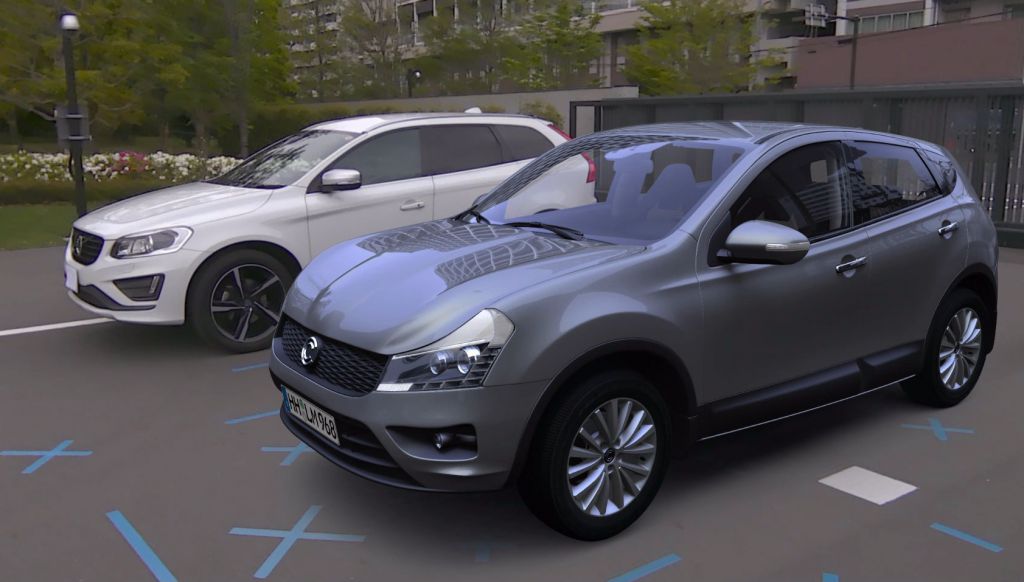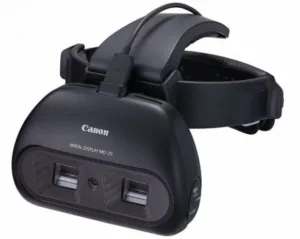Canon has unveiled the successor to last year’s MREAL MD-10 enterprise focused, mixed reality headset. It is called the MREAL Display MD-20. The headset is tethered and therefore can leverage the graphics capabilities of a powerful PC. The headset is illustrated below.

Canon MREAL Display MD-20 headset.
When looking at the headset, it appears somewhat ordinary. The MD-20 consists of a black plastic housing and is held in front of the user’s face using a large padded head ring. As will be seen below, some MD-20 specification make the headset not at all ordinary.
The MD-20 optical system includes two displays and provides an image with a resolution of 2,560 x 1,600 pixels to each eye. The image is refreshed at a rate of 60 frames per second.
The MREAL Display MD-20 contains several improvements as compared to the MD-10.
First, the MD-20 display body plus head mount unit is lighter at 640 grams. Next, the MD-20 can produce an image having an expanded color gamut. The headset is able to produce images that can now include colors that extend over 99% of the sRGB color space. (Note that sRGB is an RGB color space that HP and Microsoft created cooperatively in 1996 to use on monitors, printers and the Internet.) The new headset also has a slightly wider field of view of 70 degrees horizontal and 40 degrees vertical.
Integrated into the headset is a front facing camera that includes three CMOS sensors that are aligned with the line of sight of the wearer. The sensors have so-called global shutters which the company represents will “accurately capture real-world images without distortion.” The sensor has a resolution of 2,560 x 2,048 pixels with a field of view of 81 degrees horizontal x 69 degrees vertical.
Utilizing the sensors, the MD-20 scans the real world environment generating a real time 3D spatial map. The map enables accurate placement of 3D virtual objects with respect to real world objects and to do so even when the wearer moves.
Optional external markers and optical sensors are available that can further augment the capability to provide 3D positioning data without having to leverage on-device mapping.
Add all these features and capabilities together and the new mixed reality headset can deliver high precision composting of both real and computer generated imagery. In Canon’s words, the result is an image that will “fuse the real world with 3D CG in real time.”
A sample image that serves to illustrate this claim appears in the figure below. In the figure, a real object is seen seamlessly fused with a 3D computer generated object.
 A sample image produced by the Canon MREAL Display M-20 headset. A real car is on the left while a 3D computer generated car is on the right.
A sample image produced by the Canon MREAL Display M-20 headset. A real car is on the left while a 3D computer generated car is on the right.
The MD-20 can be used for functions beyond that of photorealistic visualization of 3D objects. The headset can also display a virtual touch menu interface that can be used for controls or as a means to access applications. Applications include those provided by Canon as well as those provided by third parties. The new Canon headset is also compatible with MREAL software that was built for the MD-10.
The MD-20 is described by the company as still under development. Apparently Canon is still working to further miniaturize and reduce the weight of the headset as well as to improve the headset’s room scale positioning.
The MREAL Display MD-20 is planned to be sold in the Japanese market. It is described as a business support tool for the manufacturing industry with specific mention made of automotive applications.
The MREAL Display MD-20, does not yet have a release date. Canon is, however, planning to show the headset at this year’s 3D and Virtual Reality Exhibition which will be held at Makuhari Messe in Chiba, Japan from February 26th to 28th.
An official price for the headset has not yet been released but the ~$82,300 price of its predecessor indicates that it is likely to be very expensive. -Arthur Berman

